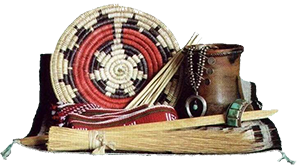 On March 4, 1933, United States President Franklin D. Roosevelt appointed John Collier as the new Commissioner of Indian Affairs. As a part of President Roosevelt's New Deal, Mr. Collier started his program of reform with the Navajos. The Navajo reservation has been divided into seperate agency jurisdiction beginning in 1910. The reservation was divided into 6 districts with an agent in each district. In 1921, with the discovery of oil on the reservation, a "council" of Navajos signed the oil and gas leases with the Midwest Refining Company. The leases were cancelled and a "business council" was organized with Chee Dodge as chairman.
On March 4, 1933, United States President Franklin D. Roosevelt appointed John Collier as the new Commissioner of Indian Affairs. As a part of President Roosevelt's New Deal, Mr. Collier started his program of reform with the Navajos. The Navajo reservation has been divided into seperate agency jurisdiction beginning in 1910. The reservation was divided into 6 districts with an agent in each district. In 1921, with the discovery of oil on the reservation, a "council" of Navajos signed the oil and gas leases with the Midwest Refining Company. The leases were cancelled and a "business council" was organized with Chee Dodge as chairman.
The legality of this council was questioned and moves were taken to form a Navajo Tribal Council with elected officials. In the subsequent election Chee Dodge was chosen Tribal Council Chairman. Dodge served as Chairman until 1928 and was re-elected to a 4 year term in 1942. the Tribal Council as devised by Commissioner Charles M. Burke, was composed of one delegate and one alternate from 6 districts, as well as chairman and a vice-chairman. the first meeting of the council was held at Todalena, New Mexico on July 27, 1923.
In 1927, John Hunter, Superintendent of the Leupp Agency, began the development of local community organizations which came to be known as Chapters. Chapter meetings were designed to bring the Navajos together at a local level where representatives of the tribe, the Public Health Service and the Indian Bureau could discuss problems in an open meeting.
Because of the stock-reduction controversy in the 1920's, the Navajo Tribal Council came into open conflict with a significant proportion of the Navajo electorate. John Collier urged a reorganization of the council along constitutional lines but that plan was thwarted when, in an 1934 election, the Navajos rejected the Indian Reorganization act - - mostly because the Tribal Council urged that they vote for it.
Collier continued to advocate Navajo self-government and selected Window Rock, Arizona as the site for the new Navajo Central Agency. In November, 1936, at the urging of Commissioner Collier, the Tribal Council appointed an Executive Committee, headed by Henry Talliman "to call a constitutional asembly for the purpose of considering adopting a constitution and bylaws for the Navajo people."
The Assembly, attended by almost 250 Navajos, convened early the next year and drafted a constitution. the constitution was rejected by Secretary Harold Ickes but he did agree to a set of regulations which included election procedures, a difinition of organization of the governing body, a statement of its powers and a description of its mode of operation.
Finally, in 1938, Secretary Ickes recognized the constitutional assembly as the new Tribal Council and promulgated regulations for its guidance; the new council membership was enlarged to severty-four delegates from "election communities"; the use of the secret ballot was instigated and the minimum voting age was set at twnety-one years. The regulations issued in 1938 remain today as the basis of Navajo tribal government and while they do not constitute exact self-government, de facto self-government has existed on the Navajo reservation since the early 1950s.